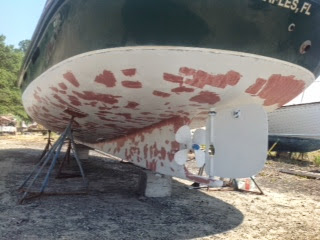The following explanation of 'built down' versus 'skeg' was taken from: http://www.boatdesign.net/forums/boat-building/please-explain-built-down-hull-2530.html
In a "built-down" hull (pictured on left) the planking forms the "tuck" in the transition from the hull to the skeg. Internally this forms a well that the shaft runs and allows a short bore-hole through the sternpost. In a "skeg" hull (pictured on right), the planking follows the hull buttock lines in a flowing line to the transom, and the skeg is built up of deadwoods and bolted through the keel. This is easier to build, but requires a long shaft bore-hole.
There are very vocal camps on both sides of the question of which method is best. Please be aware that I grew up in "built-down" country, so I may be biased. The pro - con arguments (assuming traditional plank-on-frame wooden construction) run like this:
a built-down hull is stronger
a built-down hull is more prone to garboard rot
a skeg hull is faster because of less wetted surface
a skeg hull is prone to becoming loose due to working of the keelbolts
a skeg hull is easier to build
a built-down hull is more seaworthy
and on and on and on ....
The terms 'built down hull' and 'skeg' hull are more appropriate for wood hulls, but what's being described certainly applies to fiberglass hulls too. Tommy Chen hadn't heard the term 'built down hull' before. After seeing a picture of a 'built down hull' he said that was how they made the wood CT ketches (this was around 1967--incidentally, his pay in the boat yard at the time was TW$60/day or US$1.50/day). As the photo above shows, an LNVT hull is more like a 'skeg' hull. However, rather than a right angle transition between the hull and skeg that would be found on a wood hull, fiberglass building techniques require a radiused transition. An LNVT's radius is approximately 4".



No comments:
Post a Comment